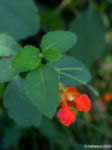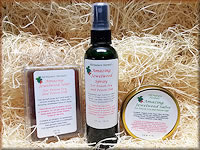Ethical Herb Wildcrafting
By Jim FlocchiniAs I walk the ground I live on, as an herbalist, I am reminded of the responsibility I have to take care of the Earth. One of the ways I feel I am able to care for her is by the way I harvest and care for the wild plant communities that I gather medicine from. It is important for me to view that the places I gather from are wild gardens that I am attempting to take care of and nurture, just as I would my home garden.
Here a couple important points to consider prior to going out and harvesting:
Is the plant on a rare, endangered or threatened plant list? This information is readily available from your state or local chapter of the Native Plant Society. Plants for the commercial herb market have been over-harvested for years. Herbs like Wild Ginseng and Goldenseal are two such plants that have been exploited to such a degree that they are extinct, rare, or threatened in many states. All in the name of the almighty
dollar. Ask yourself, "What is my intention in harvesting the herbs?"
Once I've established that the plant in question are ethically appropriate to harvest, I make sure that I find a healthy family of plants. I also want to stress the importance of knowing what animals live in the area. Wild plant communities are food and homes to many animals and insects. It is important to become familiar with the whole biological community in question.
When you walk into the woods, desert, or along a mountain stream with the intention of wildcrafting, practice opening all your senses. Become aware of how ALIVE you are, of how alive nature is. Let your peripheral vision expand: Notice the wind blowing the pollen off the pines. See if you can find the presence of deer or porcupine, chickadee or hawk. Whose been eating this plant or drinking from that water whole? Use your nose. Smell things: rocks, bark, soil, composted leaves, flowers, bugs, animal scat, leaves, water, air. Tune your hearing to the smallest of noises: be aware of and listen to the almost imperceptible whisper of water dripping off the moss of a spring. Find where the buzz of a bee is coming from. Become aware of the song leaves make, as wind rubs them together.
When I open myself in this way, I know I am ALIVE! I know how connected I am to the place I walk. I remember my place, my connection. I enter Sacred Space and know that I am the earth. By familiarizing myself in this way, I become much more aware of my place in the circle of life. I understand on a greater level the responsibility I carry, to have as little impact on the plants, animals, and overall habitat that I become involved with.
Some things to consider when looking for a healthy, viable plant community are: "How will I impact the place? If I gather from steep terrain, will it cause erosion? If the plants are surrounded by other plants, what impact will I have on them in order to reach the plants I am gathering? Is there only one community of these plants in the area? Is it the right time to gather? If the plant is stronger in fall (roots) has it flowered and gone to seed yet? Was it a good year for seed production? Was it drought conditions? If so, that will have an influence on whether or not I should gather that plant?"
I make it a practice not to gather from the first plant I see. Rather, I look for a very large, healthy plant and sit down by it's side. I believe it is important to tune into the plant and talk to it, ask it if it's ok to gather from the area, and state your intention. I make an offering and listen (some offer tobacco, some a piece of their hair, others corn meal. Be creative, and offer something.) The more I tune into the plants and with the earth I walk upon, the easier it is for me to hear an answer. When gathering, smile, think beautiful thoughts, and sing a song to the plants. The more I do this, the easier it is for me to know whether I am taking too much of one plant or harvesting from too many plants.
There are some general guidelines of harvesting that ethical wildcrafters follow. The utmost important aspect to always be thinking about is, "Will my gathering add to, or take away from the plant community? Will it be re-generating or de-generating?" Gathering no more than 1/10th of a large stand of plants may seem very conservative to some, but if it is going to take away from the over-all health of the community, then it is too much. Therefore, there is no "one" formula for gathering. It all depends on the individual place you gather from.
When I gather from a plant, I make sure I can't really notice a difference on the plant from the amount that I gather. The plant basically looks the same as it did before I gathered from it. Gather leaves after the plant has flowered to ensure enough photosynthesis potential to flower and seed-out. When harvesting bark, go out early spring or after storms and find branches that have been downed by snow or heavy winds. If that is not possible, prune a limb, and peel the bark instead of peeling from the main trunk. Peel the bark off and use the small twigs as well. Make sure you seal up the wound with mud after the incision is made. This helps protect the tree from disease or bug infestation at the wound. When gathering flowers, make sure the plants will produce enough flowers to regenerate itself. I like to avoid the flowers that insects are sleeping in or gathering pollen from. They were there first so I move on to the next one. When gathering roots, try to avoid steep terrain where erosion is more apt to occur. Find low sloped areas instead. Fall or Spring is the best time to gather roots. If it is a perennial plant, gather in the fall after seeds have been dispersed. Find out if the plant in question has beneficial use of the rest of the plant, so it doesn't go to waste. If not, I like to bury the rest of the plant in the hole I dug. Also, important to note is that by cutting off a piece of the root crown and burying it back in the hole, you help regenerate the plant.
Try not to harvest too many different types of plants in the same day. This helps you concentrate on those special plants that you've gathered. Also, try and process the harvested plants as soon as possible after you've gathered them. This both makes much stronger medicine and reduces the chance of spoilage.
If you can, gather your herbs more than 500 yards away from roads. And, if you gather on private property, make sure you get permission from the land owner. Usually they are more than happy that you are going to "weed" for them.
These are a few of the important aspects to gathering in an ethical manner. For a detailed account of ethical wildcrafting, I highly recommend Gregory Tilford's book: "The EcoHerbalist's Fieldbook"
E-mail Alternative Nature
Back to Library





